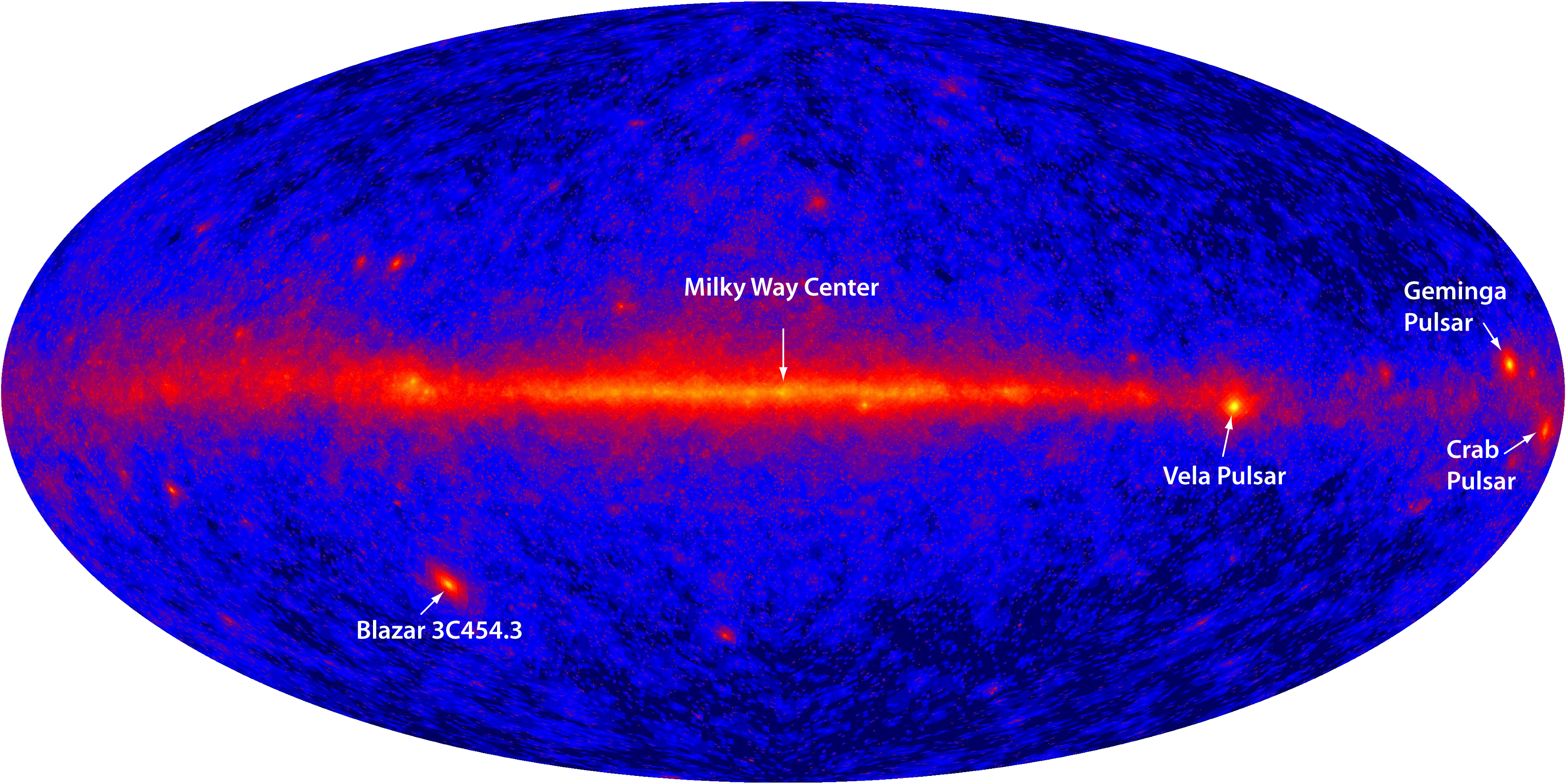|
Crab Nebula
The Crab Nebula (catalogue designations M1, NGC 1952, Taurus A) is a supernova remnant and pulsar wind nebula in the constellation of Taurus (constellation), Taurus. The common name comes from a drawing that somewhat resembled a crab with arms produced by William Parsons, 3rd Earl of Rosse, in 1842 or 1843 using a telescope. The nebula was discovered by English astronomer John Bevis in 1731. It corresponds with SN 1054, a bright supernova observed in 1054 C.E. by Native American, Japanese, and Arabic stargazers; this supernova was also recorded by Chinese astronomy, Chinese astronomers as a Guest star (astronomy), guest star. The nebula was the first astronomical object identified that corresponds with a historically-observed supernova explosion. At an apparent magnitude of 8.4, comparable to that of Titan (moon), Saturn's moon Titan, it is not visible to the naked eye but can be made out using binoculars under favourable conditions. The nebula lies in the Perseus Arm of the ... [...More Info...] [...Related Items...] OR: [Wikipedia] [Google] [Baidu] |
Guest Star (astronomy)
In Chinese astronomy, a guest star () is a star which has suddenly appeared in a place where no star had previously been observed and becomes invisible again after some time. The term is a literal translation from Chinese astronomy#Early history, ancient Chinese astronomical records. Modern astronomy recognizes that guest stars are manifestations of cataclysmic variable stars: novae and supernovae. The term "guest star" is used in the context of ancient records, since the exact classification of an astronomical event in question is based on interpretations of old records, including inference, rather than on direct observations. In ancient Chinese astronomy, guest stars were one of the three types of highly transient objects (bright heavenly bodies). The other two were comets with tails () and comets without tails (), with the former term being used for all comets in modern astronomy. The earliest Chinese record of guest stars is contained in ''Han Shu'' (漢書), the history o ... [...More Info...] [...Related Items...] OR: [Wikipedia] [Google] [Baidu] |
X-ray
An X-ray (also known in many languages as Röntgen radiation) is a form of high-energy electromagnetic radiation with a wavelength shorter than those of ultraviolet rays and longer than those of gamma rays. Roughly, X-rays have a wavelength ranging from 10 Nanometre, nanometers to 10 Picometre, picometers, corresponding to frequency, frequencies in the range of 30 Hertz, petahertz to 30 Hertz, exahertz ( to ) and photon energies in the range of 100 electronvolt, eV to 100 keV, respectively. X-rays were discovered in 1895 in science, 1895 by the German scientist Wilhelm Röntgen, Wilhelm Conrad Röntgen, who named it ''X-radiation'' to signify an unknown type of radiation.Novelline, Robert (1997). ''Squire's Fundamentals of Radiology''. Harvard University Press. 5th edition. . X-rays can penetrate many solid substances such as construction materials and living tissue, so X-ray radiography is widely used in medical diagnostics (e.g., checking for Bo ... [...More Info...] [...Related Items...] OR: [Wikipedia] [Google] [Baidu] |
Radio Wave
Radio waves (formerly called Hertzian waves) are a type of electromagnetic radiation with the lowest frequencies and the longest wavelengths in the electromagnetic spectrum, typically with frequencies below 300 gigahertz (GHz) and wavelengths greater than , about the diameter of a grain of rice. Radio waves with frequencies above about 1 GHz and wavelengths shorter than 30 centimeters are called microwaves. Like all electromagnetic waves, radio waves in vacuum travel at the speed of light, and in the Earth's atmosphere at a slightly lower speed. Radio waves are generated by charged particles undergoing acceleration, such as time-varying electric currents. Naturally occurring radio waves are emitted by lightning and astronomical radio source, astronomical objects, and are part of the blackbody radiation emitted by all warm objects. Radio waves are generated artificially by an electronic device called a transmitter, which is connected to an antenna (radio), antenna, w ... [...More Info...] [...Related Items...] OR: [Wikipedia] [Google] [Baidu] |
Gamma Ray
A gamma ray, also known as gamma radiation (symbol ), is a penetrating form of electromagnetic radiation arising from high energy interactions like the radioactive decay of atomic nuclei or astronomical events like solar flares. It consists of the shortest wavelength electromagnetic waves, typically shorter than those of X-rays. With frequencies above 30 exahertz () and wavelengths less than 10 picometers (), gamma ray photons have the highest photon energy of any form of electromagnetic radiation. Paul Villard, a French chemist and physicist, discovered gamma radiation in 1900 while studying radiation emitted by radium. In 1903, Ernest Rutherford named this radiation ''gamma rays'' based on their relatively strong penetration of matter; in 1900, he had already named two less penetrating types of decay radiation (discovered by Henri Becquerel) alpha rays and beta rays in ascending order of penetrating power. Gamma rays from radioactive decay are in the energy range ... [...More Info...] [...Related Items...] OR: [Wikipedia] [Google] [Baidu] |
Radiation
In physics, radiation is the emission or transmission of energy in the form of waves or particles through space or a material medium. This includes: * ''electromagnetic radiation'' consisting of photons, such as radio waves, microwaves, infrared, visible light, ultraviolet, x-rays, and Gamma ray, gamma radiation (γ) * ''particle radiation'' consisting of particles of non-zero rest energy, such as alpha radiation (α), beta radiation (β), proton radiation and neutron radiation * ''acoustics, acoustic radiation'', such as ultrasound, sound, and seismic waves, all dependent on a physical transmission medium * ''gravitational radiation'', in the form of gravitational waves, ripples in spacetime Radiation is often categorized as either ''ionizing radiation, ionizing'' or ''non-ionizing radiation, non-ionizing'' depending on the energy of the radiated particles. Ionizing radiation carries more than 10 electron volt, electron volts (eV), which is enough to ionize atoms and molecul ... [...More Info...] [...Related Items...] OR: [Wikipedia] [Google] [Baidu] |
Neutron Star
A neutron star is the gravitationally collapsed Stellar core, core of a massive supergiant star. It results from the supernova explosion of a stellar evolution#Massive star, massive star—combined with gravitational collapse—that compresses the core past white dwarf star density to that of Atomic nucleus, atomic nuclei. Surpassed only by black holes, neutron stars are the second smallest and densest known class of stellar objects. Neutron stars have a radius on the order of and a mass of about . Stars that collapse into neutron stars have a total mass of between 10 and 25 solar masses (), or possibly more for those that are especially rich in Metallicity, elements heavier than hydrogen and helium. Once formed, neutron stars no longer actively generate heat and cool over time, but they may still evolve further through Stellar collision, collisions or Accretion (astrophysics), accretion. Most of the basic models for these objects imply that they are composed almost entirely o ... [...More Info...] [...Related Items...] OR: [Wikipedia] [Google] [Baidu] |
Crab Pulsar
The Crab Pulsar (PSR B0531+21 or Baade's Star) is a relatively young neutron star. The star is the central star in the Crab Nebula, a remnant of the supernova SN 1054, which was widely observed on Earth in the year 1054.Supernova 1054 – Creation of the Crab Nebula Discovered in 1968, the was the first to be connected with a supernova remnant.  The Crab Pulsar is one of very few pulsars to be identified optically. The
The Crab Pulsar is one of very few pulsars to be identified optically. The [...More Info...] [...Related Items...] OR: [Wikipedia] [Google] [Baidu] |
Speed Of Light
The speed of light in vacuum, commonly denoted , is a universal physical constant exactly equal to ). It is exact because, by international agreement, a metre is defined as the length of the path travelled by light in vacuum during a time interval of second. The speed of light is invariant (physics), the same for all observers, no matter their relative velocity. It is the upper limit for the speed at which Information#Physics_and_determinacy, information, matter, or energy can travel through Space#Relativity, space. All forms of electromagnetic radiation, including visible light, travel at the speed of light. For many practical purposes, light and other electromagnetic waves will appear to propagate instantaneously, but for long distances and sensitive measurements, their finite speed has noticeable effects. Much starlight viewed on Earth is from the distant past, allowing humans to study the history of the universe by viewing distant objects. When Data communication, comm ... [...More Info...] [...Related Items...] OR: [Wikipedia] [Google] [Baidu] |
Arcminute
A minute of arc, arcminute (abbreviated as arcmin), arc minute, or minute arc, denoted by the symbol , is a unit of angular measurement equal to of a degree. Since one degree is of a turn, or complete rotation, one arcminute is of a turn. The nautical mile (nmi) was originally defined as the arc length of a minute of latitude on a spherical Earth, so the actual Earth's circumference is very near . A minute of arc is of a radian. A second of arc, arcsecond (abbreviated as arcsec), or arc second, denoted by the symbol , is a unit of angular measurement equal to of a minute of arc, of a degree, of a turn, and (about ) of a radian. These units originated in Babylonian astronomy as sexagesimal (base 60) subdivisions of the degree; they are used in fields that involve very small angles, such as astronomy, optometry, ophthalmology, optics, navigation, land surveying, and marksmanship. To express even smaller angles, standard SI prefixes can be employed; the milliarcse ... [...More Info...] [...Related Items...] OR: [Wikipedia] [Google] [Baidu] |
Milky Way
The Milky Way or Milky Way Galaxy is the galaxy that includes the Solar System, with the name describing the #Appearance, galaxy's appearance from Earth: a hazy band of light seen in the night sky formed from stars in other arms of the galaxy, which are so far away that they cannot be individually distinguished by the naked eye. The Milky Way is a barred spiral galaxy with a Galaxy#Isophotal diameter, D25 isophotal diameter estimated at , but only about 1,000 light-years thick at the spiral arms (more at the bulge). Recent simulations suggest that a dark matter area, also containing some visible stars, may extend up to a diameter of almost 2 million light-years (613 kpc). The Milky Way has several List of Milky Way's satellite galaxies, satellite galaxies and is part of the Local Group of galaxies, forming part of the Virgo Supercluster which is itself a component of the Laniakea Supercluster. It is estimated to contain 100–400 billion stars and at least that number of pla ... [...More Info...] [...Related Items...] OR: [Wikipedia] [Google] [Baidu] |
Perseus Arm
The Perseus Arm is one of two major spiral arms of the Milky Way galaxy. The second major arm is called the Scutum–Centaurus Arm. The Perseus Arm begins from the distal end of the long Milky Way central bar. Previously thought to be 13,000 light-years away, it is now thought to lie 6,400 light years from the Solar System. Overview The Milky Way is a barred spiral galaxy with two major arms and a number of minor arms or spurs. The Perseus Spiral Arm, with a radius of approximately 10.7 kiloparsecs, is located between the minor Cygnus Arm, Cygnus and Carina–Sagittarius Arms. It is named after the Perseus (constellation), Perseus constellation in the direction of which it is seen from Earth. Recently, scientists in two large radio astronomy projects, the Bar and Spiral Structure Legacy (BeSSeL) Survey and the Japanese VLBI Exploration of Radio Astrometry (VERA), have made great efforts over about 20 years to measure the trigonometric parallaxes toward about 200 water vapor ... [...More Info...] [...Related Items...] OR: [Wikipedia] [Google] [Baidu] |





